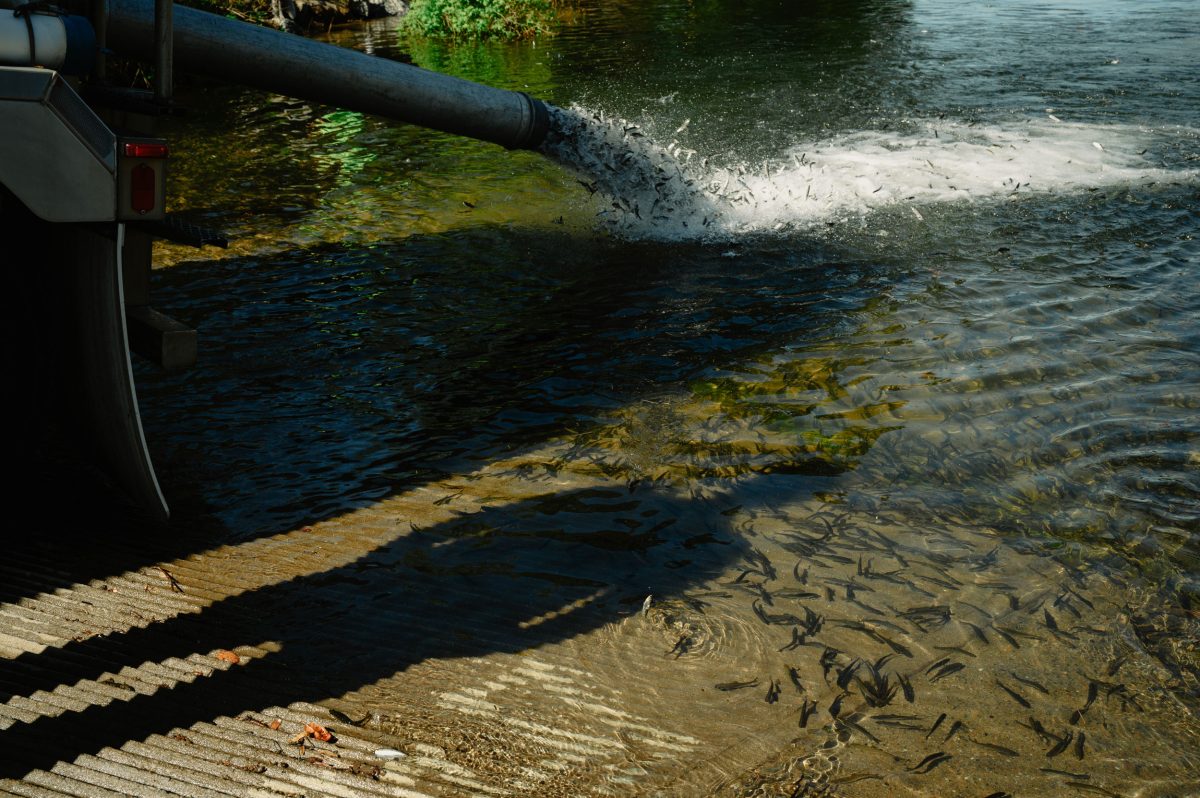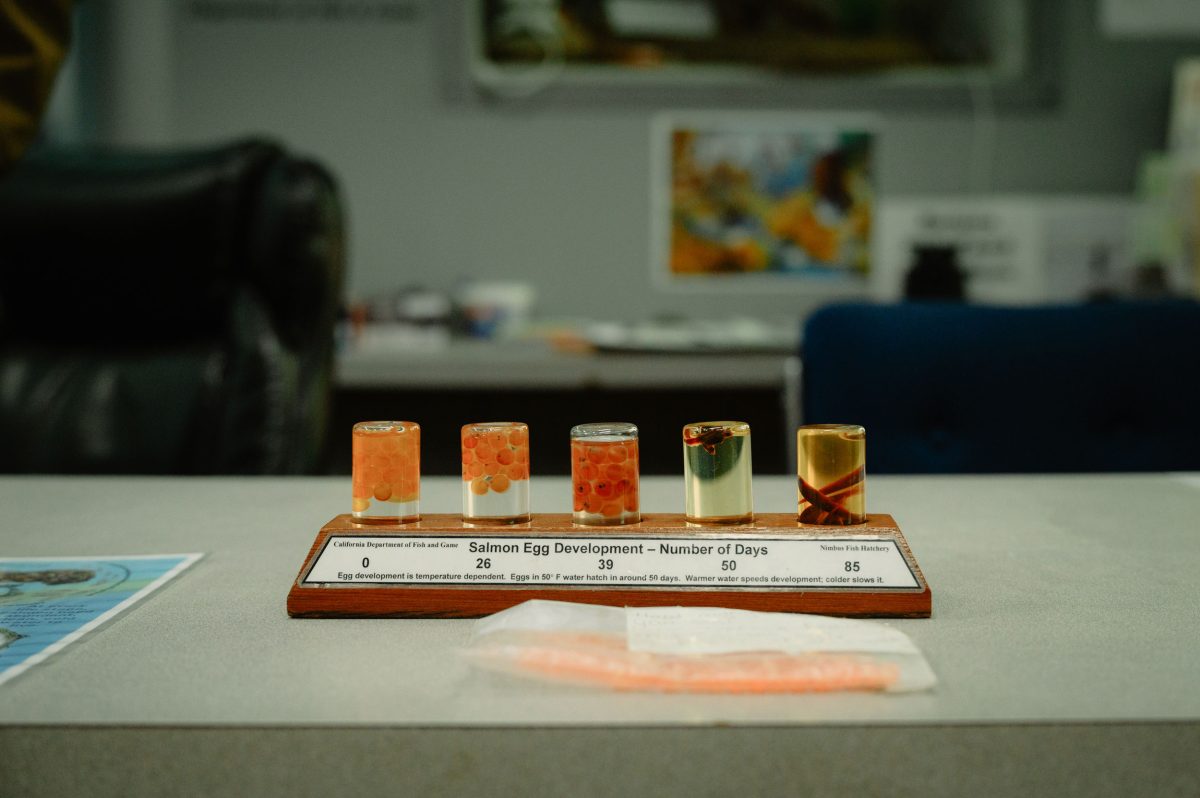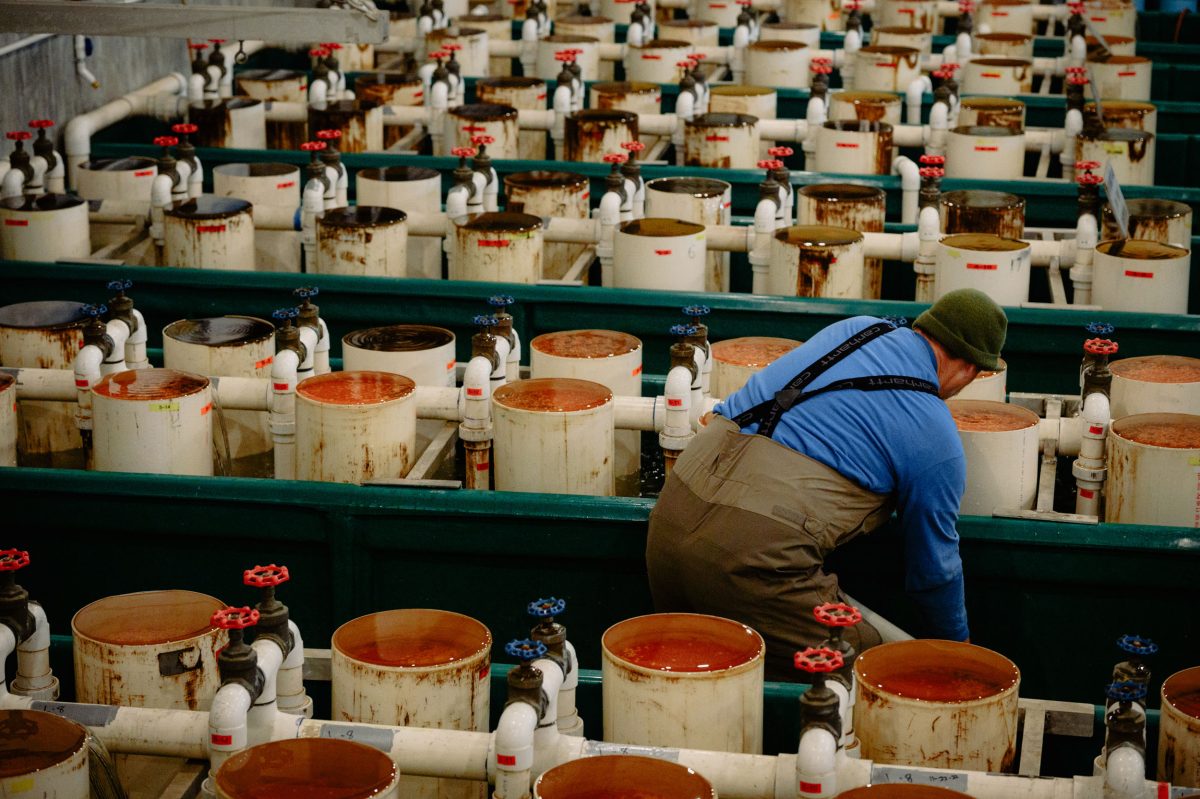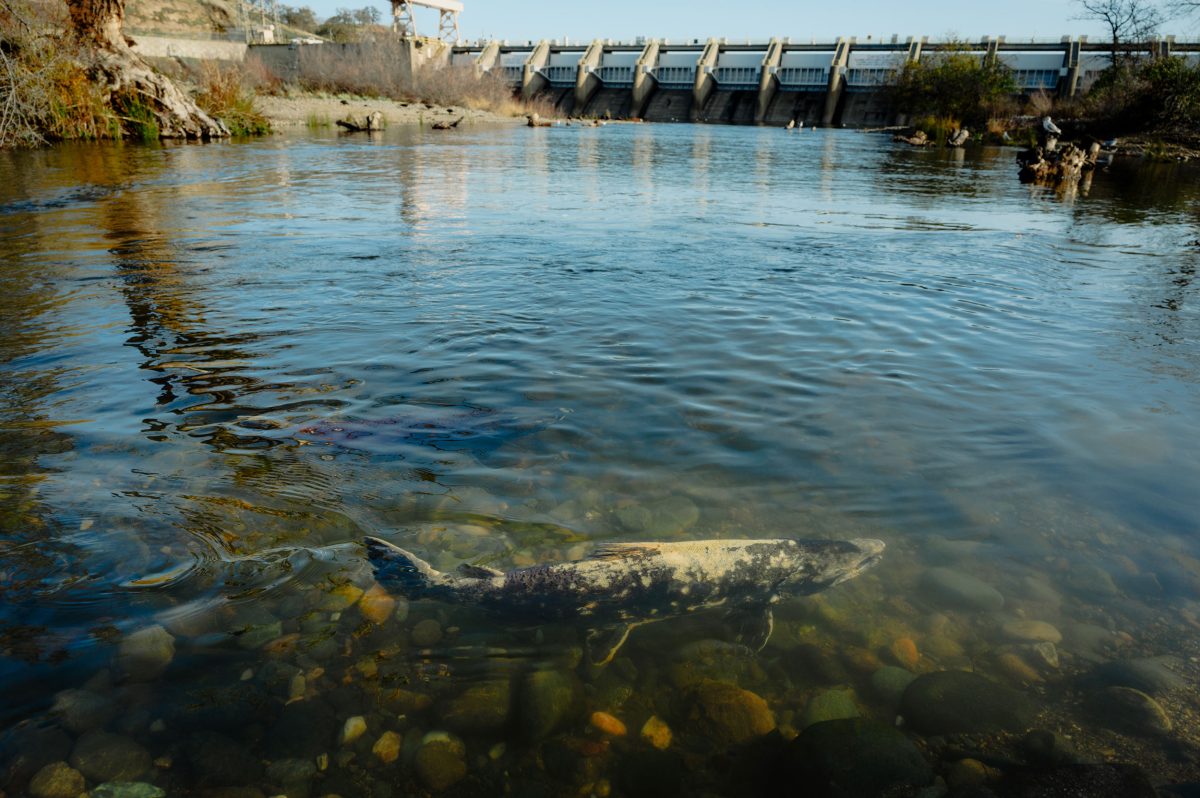California’s Central Valley Chinook Are Getting Lost on Their Way Home
The culprit is a tactic designed to save the salmon—one that could decrease the species’ resilience in the long run.
Article body copy
This story was originally published by High Country News, a magazine about the American West’s environment and communities, and is reproduced here with permission.
Picture yourself: a chinook salmon in the prime of your life. You dart through the water off California’s central coast, winding through kelp and dodging hungry sea lions. Long, sleek and silver, dappled with dark spots. Eyes wide and vigilant. More than 20 kilograms of pure muscle.
You’ve been out at sea for several years now, first voyaging north along the Oregon coastline, then westward into deeper water. As winter approaches and the days grow shorter, you’ve found your way back to California. You’ve felt the seasons turn before, but this year, it means something special.
Your kind, the Central Valley chinook—what fishers call the king salmon—are not born at sea. For thousands of years, your ancestors began their lives in the heart of California, where tributaries and streams flow together to form the mighty Sacramento and San Joaquin Rivers. They fanned out across the valley—through forested streams, desert rivers, and delta wetlands. There, hundreds of kilometers from the ocean, hatchlings the size of paper clips wriggled free from eggs the color of the sun. There, as young salmon fry, they floated, taking in the scent of their birth river—the beginnings of a map they would use to find their way back one day. There, they felt the pull of the water, surrendered themselves to the current, and began the long journey downstream.
But, over the last 200 years, California has changed, and your kind has changed along with it. The state’s rivers have become divided and parched, first by European settlers searching for gold, then by the federal government and a vast network of dams built to divert water to supply growing cities and farms, and now, by years of climate change–fueled drought. Much of those cold-water spawning grounds have vanished, and many chinook have followed.
Still, some have endured. Imagine you’re one of them, born not on a riverbed but at a hatchery—a human-made facility built to help salmon survive the damming of their spawning grounds. Now, after years at sea, you have grown large and strong and carry thousands of eggs. You still remember the smell of the tributary where your hatchery stood. The river calls you home.

Workers at the Nimbus Fish Hatchery in Gold River, California, conduct the first downstream release of young fall-run Central Valley chinook salmon of the year in May 2023.
You find the mouth of the San Francisco Bay and dart through, using the scent of the water to guide you north. The water becomes dark and murky, clouded with silt and vibrating as massive cargo ships carve through the surface of the water above. As you continue, the taste of the water changes again. Darkness and salt give way to fresher waters as you swim below a long, curving bridge. The waters of the bay squeeze between the banks of the Sacramento River. Cities and highways become towns and fields as you travel through the Bay Delta. You remember the smell of this place. As a young smolt, this was dangerous territory—where striped bass and other predators lurked. Now, as an adult salmon, heavy and muscular, you move through without trouble.
But something is wrong. As you push north along the Sacramento River, you arrive at a fork, and suddenly, the trail goes cold. You swim back and forth, searching for a familiar scent, but those smells have vanished. You don’t remember these waters.
You are lost.
Across California’s Central Valley, more and more salmon are getting lost as they migrate back to their spawning grounds. The culprit is a conservation tactic meant to help save them—and it all starts at the hatcheries.
On a warm morning this past June, a group of workers at Nimbus Fish Hatchery, just a few kilometers north of Sacramento, tended to pools filled with young chinook. One of the hatchery workers waded through the water, corralling the tiny, finger-length smolts at one end of the pool. A pump roared to life, sucking the fish up through a giant plastic tube and into the back of a large silver tanker truck. The fish rose from the pools that had given them life, their tiny silhouettes thrashing against the morning sky. By the time the pump went silent, tens of thousands of young salmon had been packed into the truck, ready to be driven toward the sea.

A display at the Nimbus Fish Hatchery visitor center in Gold River, California, shows the early life cycle of a young salmon.
As salmon numbers have plummeted along the West Coast, state and federal officials in the United States have looked to more aggressive measures to stave off collapse. They first built dozens of salmon hatcheries like Nimbus, facilities Congress funded to make up for the construction of massive dams that cut the fish off from their historic spawning grounds. Then, they created giant staircases to help salmon scale the dams themselves. In recent decades, they have reared some salmon in flooded rice fields and used pressurized tubes to launch others up and over obstacles.
In California’s Central Valley, one tactic has drawn particular attention: packing young salmon into trucks and physically hauling them downstream.
These efforts began to ramp up in the 1980s when officials worried that young hatchery salmon were dying in rivers before they could even make it to the ocean. Trucking, they reasoned, could bypass that risk by ferrying the young fish to release points farther downstream or all the way to San Francisco Bay, giving more of them a chance to begin the next phase of their life. At the urging of commercial fishing industry leaders, hatcheries began driving small loads of fish to the ocean. As drought conditions intensified, fueled by climate change, hatcheries began to truck more and more young salmon. Within decades, millions of fish were trundling down the highway—a tactic that researchers say is undeniably bolstering the number of Central Valley chinook salmon that are alive today.
But, according to a growing body of scientific evidence, it’s also the reason many salmon are getting lost on their way back to their birth rivers, placing the future resilience of the species at risk.

A worker tends to containers of fall-run Central Valley chinook salmon eggs at Nimbus Fish Hatchery in Gold River, California.
In a 2019 study published in the journal Fisheries, researchers found that the farther salmon were trucked from their birthplace, the more likely they were to wander into a different river when they came back. Typically, as the young fish travel downstream, they log the scent of different streams, creating a series of waypoints they will one day use to find their way home. But sloshing around in the metal drums of trucks, disoriented and confused, young fish are completely cut off from the smell of the river.
These trucked hatchery fish may survive longer in the short term, but they will return to the river system years later with massive gaps in their memory and little sense of how to locate their spawning grounds. Instead, many end up wandering up unfamiliar rivers or streams and spawning far from home.
“It’s very much a double-edged sword,” says Anna Sturrock, a lead author on the Fisheries study and an aquatic ecologist at the University of Essex in the United Kingdom.
The main problem is that the stray salmon are all hatchery fish. Salmon born in hatcheries are less prepared to survive in the wild after being reared in a gentle environment with plenty of food and few predators. As they stray into different rivers, they compete and breed with the remaining wild salmon, depleting the species’ genetic diversity and perhaps weakening its ability to endure threats like climate change or disease outbreaks.

Young fall-run Central Valley chinook salmon swim in one of the concrete pools at the Nimbus Fish Hatchery in Gold River, California, in spring 2023.
And the Central Valley chinook are already far more vulnerable to these kinds of environmental threats than they used to be. Generations of dam building and massive water diversions have dwindled their numbers and stripped away much of their historic diversity. Researchers have tied this reduced resilience to past events, like when salmon numbers crashed to record lows in 2008.
The risks of trucking have been a concern among officials for over a decade. In 2012, a federal review of California’s fish hatchery operations concluded that releasing salmon downstream had led to “unacceptable levels of straying” in the Sacramento–San Joaquin river system and recommended that hatcheries cease all trucking operations.
The tactic has also drawn criticism from some salmon advocates. “Trucking salmon is kind of like putting a Band-Aid on a gaping wound when you cut your leg off,” says Regina Chichizola, executive director of the Indigenous-led organization Save California Salmon. “[It] seems to me like a setup for disaster.”
Even leaders in the commercial fishing industry, which pushed the state to begin trucking in the first place, openly acknowledge the risks it poses to the health of the species. “I think anybody in our industry would acknowledge that it wasn’t the best option,” says Glen Spain, interim executive director of the Pacific Coast Federation of Fishermen’s Associations, a commercial fishing trade group. “The best option is a restored, healthy ecosystem in a restored watershed. But how we’re going to get back to that, given the over-industrialization of the Bay Delta and all the dams and water diversions—it’s anybody’s guess.”
Nevertheless, trucking has swelled from an emergency tactic to a pillar of the state’s approach to salmon. In recent years, California Department of Fish and Wildlife (CDFW) trucks have ferried millions of fish from hatcheries to the ocean.
“The valley has experienced, over the last decade, two of the worst long-term, multiyear droughts that our state has seen,” says Jason Julienne, the north central region hatchery supervisor for the CDFW. “With all strategies that we have at our disposal, there are pluses and minuses.”

An adult chinook salmon slowly makes its way upstream along the American River, east of Sacramento, California, at the tail end of the fall-run species’ spawning season.
On that warm June morning, the CDFW truck rumbled out of the hatchery and onto the main road. A second truck, also full of salmon, followed close behind. They trundled down the highway with their precious cargo, passing condominiums, strip mall law offices, and manicured lawns.
State authorities are currently searching for ways to alleviate the risks of trucking. In 2012, the CDFW began a pilot study on salmon barging, an option that involves transporting a few hundred thousand young salmon downstream from within the safety of a repurposed fishing vessel, keeping them in direct contact with the river but shielded from predators and other dangers. Sturrock, the ecologist, says fellow researchers have also discussed having salmon trucks drain and refill their tanks at different places along the river to give the young salmon some points of reference—although she says they have not yet found a way to engineer that.
But the ultimate solution, most salmon advocates and researchers say, is restoring access to the species’ lost habitat and reorganizing California’s archaic water-rights system.
California tribes are leading rewilding movements to revive salmon in the far northern parts of the state. Along the California-Oregon border, four tribal governments—the Yurok, Karuk, Hoopa Valley, and Klamath tribes—have begun the largest dam-removal project in US history with the goal of reviving the natural spawning grounds of salmon and other native species. Above Shasta Dam, scientists have been ferrying salmon eggs back upriver to help them spawn as part of a joint project between the Winnemem Wintu Tribe, the CDFW, and the National Oceanic and Atmospheric Administration to bring the endangered winter-run chinook salmon back from the brink of extinction.
The US Environmental Protection Agency has also announced that it will investigate how California manages its water. The decision came after several tribes and environmental groups filed a civil rights complaint in December 2022, accusing the California Water Board of creating an ecological crisis in the Bay Delta by diverting too much water away from the rivers, wreaking havoc on the Central Valley chinook, among other species.

Gary Mulcahy, the government liaison of the Winnemem Wintu Tribe, speaks during a rally at the state Capitol in Sacramento, California, in July 2023.
“There’s really hopeful things happening,” Save California Salmon’s Chichizola says. “Things that we thought were impossible.”
Eventually, the two CDFW trucks slowed to a halt near a parking lot along the American River. The distance hatchery workers end up transporting the young salmon depends on the location of the hatchery and how healthy the rivers are. In some cases, they end up driving loads of young chinook between 80 and 160 kilometers.
Today though, they didn’t need to take the fish that far. The Sacramento River’s tributaries were surging with cold water from the winter storms that hit California at the beginning of this year—good conditions for the salmon to make their way downstream. One by one, the trucks backed up to the water and released their cargo, sending hundreds of thousands of little fish tumbling into the river for the very first time.
You are tired. It’s been a long, hard journey to reach this fork where the Sacramento and American Rivers meet. And now, your guiding map has gone dark.
You swim back and forth slowly, allowing the water to push you backward for a few seconds, then churning your tail in a rapid burst to retake that ground. It takes energy, a lot of energy, to hold yourself in place here in the river. If you relax for even a few seconds, you could lose precious yards of progress. And you only have so long to lay your eggs.
So, what now? You could follow the rushing Sacramento River to the left and forge ahead, searching for another familiar scent. You could die here—relax and sink to the riverbed or let the water carry you back downstream. Or maybe you could take the right fork toward the American River, a river your ancestors never spawned in, to look for a new place to lay your eggs. It isn’t home, but it may be the best bet you have if you still want the new generation you carry to survive.
You swim toward it, leaving the waters you know behind.

